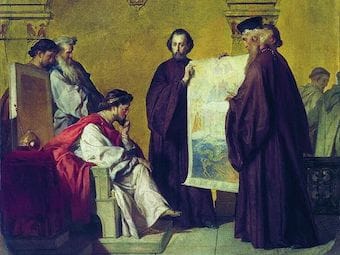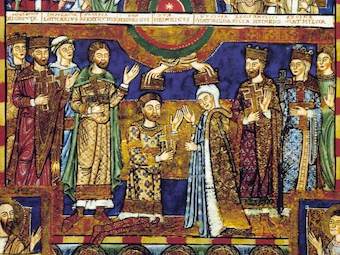1033
Two of Heracles’s labours are declared void, so to make up the number he is sent to find the Garden of the Hesperides.
Greek hero Heracles has been appointed ten Labours to atone for killing his children in a fit of madness. The Labours are set by his jealous cousin King Eurystheus, and when he learns that Heracles had help with the many-headed Hydra of Lerna and the Stables of King Augeas, he declares that two more Labours must be performed to make up the number.
Picture: © Finoa Avis, Geograph. Licence: CC BY-SA 2.0.. Source.
Posted October 28 2017
1034
The young Roman Emperor Theophilus backed away from marriage to the formidable Cassiani, but he could not forget her.
Cassiani was a nun of noble birth in the Roman Empire’s capital city, Constantinople, during the 9th century. Her gift for poetry and hymn-writing was widely admired, and the Eastern service-books are littered with her works. The most famous is a Hymn for Wednesday in Holy Week, and thereby hangs quite a tale.
Picture: From the Chronicle of John Skylitzes, via Wikimedia Commons. Licence: Public domain.. Source.
Posted October 26 2017
1035
Two young English princes were banished to the court of Yaroslav the Wise, and one returned to claim the crown.
Edward the Exile was one of two princes, sons of Edmund Ironside, driven to Kiev after the Danish warrior-king Cnut the Great took their father’s crown in 1016. In 1054, Edward returned to England with his wife and young son Edgar, encouraged by his uncle King Edward the Confessor to believe that he was about to regain his lost throne.
Picture: From the British Library, via Wikimedia Commons. Licence: Public domain.. Source.
Posted October 21 2017
1036
A succession of religious leaders came to Kiev, hoping to win the wild barbarian Prince to their cause.
The Christianity that spread across England in the 7th century spread to Kiev in the 10th, but there it had to compete not just with paganism but with Islam, Judaism, and other flavours of Christianity — and also with Vladimir, Grand Prince of Kiev (r. 980-1015), who liked his religion spicy.
Picture: Vasily Petrovich Vereshchagin (1835-1909), via Wikimedia Commons. Licence: Public domain.. Source.
Posted October 20 2017
1037
For a hundred years after William the Conqueror came to England, four strong women named Matilda shaped the nation’s history.
From 1066 to 1154, England saw no fewer than four royal women named Matilda, including the wife of William the Conqueror, and the daughter of Malcolm III of Scotland. It can be a little confusing working out which one is which, so here is a short guide.
Picture: From the Gospels of Henry the Lion (12th century), via Wikimedia Commons. Licence: Public domain.. Source.
Posted October 20 2017
1038
JB Cramer was one of the finest pianists of his day, though his reverence for Mozart made his own music more popular in the drawing room than the concert hall.
In 1772, Wilhelm Cramer, a virtuoso violinist from Stuttgart in the Duchy of Württemberg, settled in London, becoming a leading figure in concert halls and in the Court of King George III. Soon afterwards, his infant son Johann Baptist Cramer (1771-1858) joined him in England.
Picture: By William Sharp (1749-1824), via Wikimedia Commons. Licence: Public domain.. Source.
Posted October 15 2017





